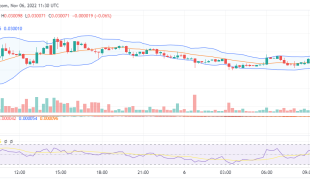Join Our Telegram channel to stay up to date on breaking news coverage
Fundamentals of the global economy
Despite the emergence of new issues, the economy is still recovering from the COVID-19 outbreak. Now that inflation is out of control, central banks are attempting to address the problem by hiking interest rates.
The consumer price index (CPI) statistics for the United States, which was published on October 13 and came in higher than predicted (8.2% year-over-year), had a negative effect on the price of bitcoin. However, the global economy is also dealing with the energy crisis, which is impacting Europe more than the United States because of its heavy reliance on Russian natural gas and raw materials. This issue is not limited to inflation.
The conflict in Ukraine and the following sanctions against Russia increase geopolitical unrest and economic uncertainty on the eastern side. Additionally, one of the largest economies in the world is being threatened by the Evergrande default and China’s zero-COVID policy, which is upending global supply chains.
When compared to other major currencies, the dollar index appears to be robust. In November, both the Bank of England and the Federal Reserve lifted interest rates by the same 75 basis points. This quantitative tightening strategy tries to constrict the money supply and lessen price pressure. It will probably last through next year and beyond. However, the possibility of a global recession and stagflation remain very high, thus no country can feel completely safe with regard to central bank monetary policy.
Relationship between BTC and the Economy
Bitcoin has demonstrated that it is not immune to current world unrest. Even though the price was initially independent of conventional finance, correlation started to emerge in 2016.
Because both shared the rarity and difficulty of extraction (mining), as well as the function of being a store of value, the idea of bitcoin as a “digital gold” gained popularity. Since many people consider bitcoin to be a risky investment, a correlation with the S&P 500 and Nasdaq-100 indexes emerged, just like with conventional stocks.
The 40-day price correlation of bitcoin to gold as of this writing was 0.50. (after being around zero in August). Bank of America strategists Alkesh Shah and Andrew Moss claim:
“As macro uncertainty persists and a market bottom remains to be seen, investors may consider bitcoin as a relative safe haven,” says the report. “A decelerating positive correlation with SPX/QQQ and a quickly rising correlation with XAU indicate this.”
Tragic Events
The collapse of Terra/LUNA, Three Arrows Capital’s forced liquidation, and Celsius’s insolvency were the primary macroeconomic variables in the greater cryptocurrency ecosystem that caused a bearish market. It is also necessary to take into account the upcoming EU rules on bitcoin mining and the existing profitability issue in the industry.
Despite all of the aforementioned negative developments, bitcoin managed to maintain a price in the $19,000–$20,000 region with historically low volatility. The bitcoin price is currently showing exceptional steadiness, recently even matching the volatility of the British pound.
On the other hand, after rumors about the Fed’s upcoming choices, markets have seen tremendous volatility and wild price swings. Mike McGlone, chief commodity strategist at Bloomberg, claims that this is the reason why bitcoin may increase after a significant discount and ultimately surpass the S&P 500. He thinks that the limited quantity of bitcoin and its deflationary strategy might help it regain its earlier price levels.
The price has been very stable since the previous flash crash in mid-June, but as we all know, that hasn’t lasted for very long. This indicates that as time passes, there is a greater chance of a dramatic breakout (bearish or bullish). The breakout will be stronger the longer the price is stagnant.
Additionally, with liquidations at an all-time low, the open interest for BTC futures is higher than ever. There is a lot of liquidity building up here, so when the price starts to move again, there will be an even larger impulse.
After a further 15% decline, the strategist Benjamin Cowen predicts that bitcoin will rise to “fair value.” The data now indicate that we are around 50% undervalued in comparison to the fair value. According to Cowen, we might have to wait until the beginning of 2024 to observe this growth.
A contrary viewpoint is held by Goldman Sachs strategist Kamakshya Trivedi, who asserts that the U.S. dollar index, which has reached record highs since 2002, may be bad news for the bitcoin market, which is now bearish.
A Doomsday Prediction: Could the 2018 Drop Repeat?
Some analysts have been speculating that the market conditions from 2018—low volatility, followed by a sharp price decline—might repeat themselves today. We share the same 10% trading range and anticipate an impending event.
In contrast to our current cycle, which is seeing liquidity leave exchanges and few new addresses being established, the 2018 cycle saw an increase in addresses sent to spot exchanges. This is a notable difference between the two cycles. An analyst for CryptoQuant believes that this should indicate that a situation like that of 2018 won’t occur.
What about the “Halloween Effect”?
In the past, the fourth quarter has been wonderful for bitcoin, with bullish patterns beginning in October and intensifying in November. So, in 2021, the months of October and November were jokingly renamed “Uptober” and “Moonvember,” respectively.
Can we still anticipate a Q4 that is so positive in 2022? It’s difficult to predict, but it’s difficult to imagine the same rally we experienced last year given the unfavorable macroeconomic environment and current geopolitical circumstances. After all, there hasn’t been any real indication of a resurgence in the bitcoin market for the past ten months. We must also keep in mind that, despite the unfavorable global situation, bitcoin’s status as a “safe haven” may help support the price, particularly during these trying times.
Transaction Data Analysis
Filbfilb examined the Bitfinex exchange’s liquidation information. He came to the conclusion that a downward breakout would have more momentum. A bullish breakthrough would be “less harsh” than a bearish one because liquidity over $20,500 is primarily 10x, but liquidity below $18,000 is primarily 10x, 5x, and 3x.
Conclusions
The bitcoin market is currently in a state of stagnation. After a two-month period of consolidation, the price of bitcoin has to resume moving. Investors might still perceive bitcoin’s significance as a safe haven and digital gold despite the broader economic outlook being quite bleak and its correlation to real-world events. A significant breakout in the price of bitcoin is anticipated, along with additional volatility.
After the price breaks through the $19,000 resistance level, two scenarios are possible: a brief price decline followed by a bullish comeback (V-shaped bounce); or a longer and deeper price decline.
Bitcoin will continue to be the most cutting-edge technology of the past ten years, enabling financial freedom and total sovereignty over one’s own wealth, no matter what occurs. In the past, there have been many significant bear markets that Bitcoin has survived and always bounced back from.
Related
- Best Cryptos to Buy Now, November 6: SOL, AXS, and IMPT
- Bitcoin and gold correlation reaches yearly highs
Join Our Telegram channel to stay up to date on breaking news coverage


